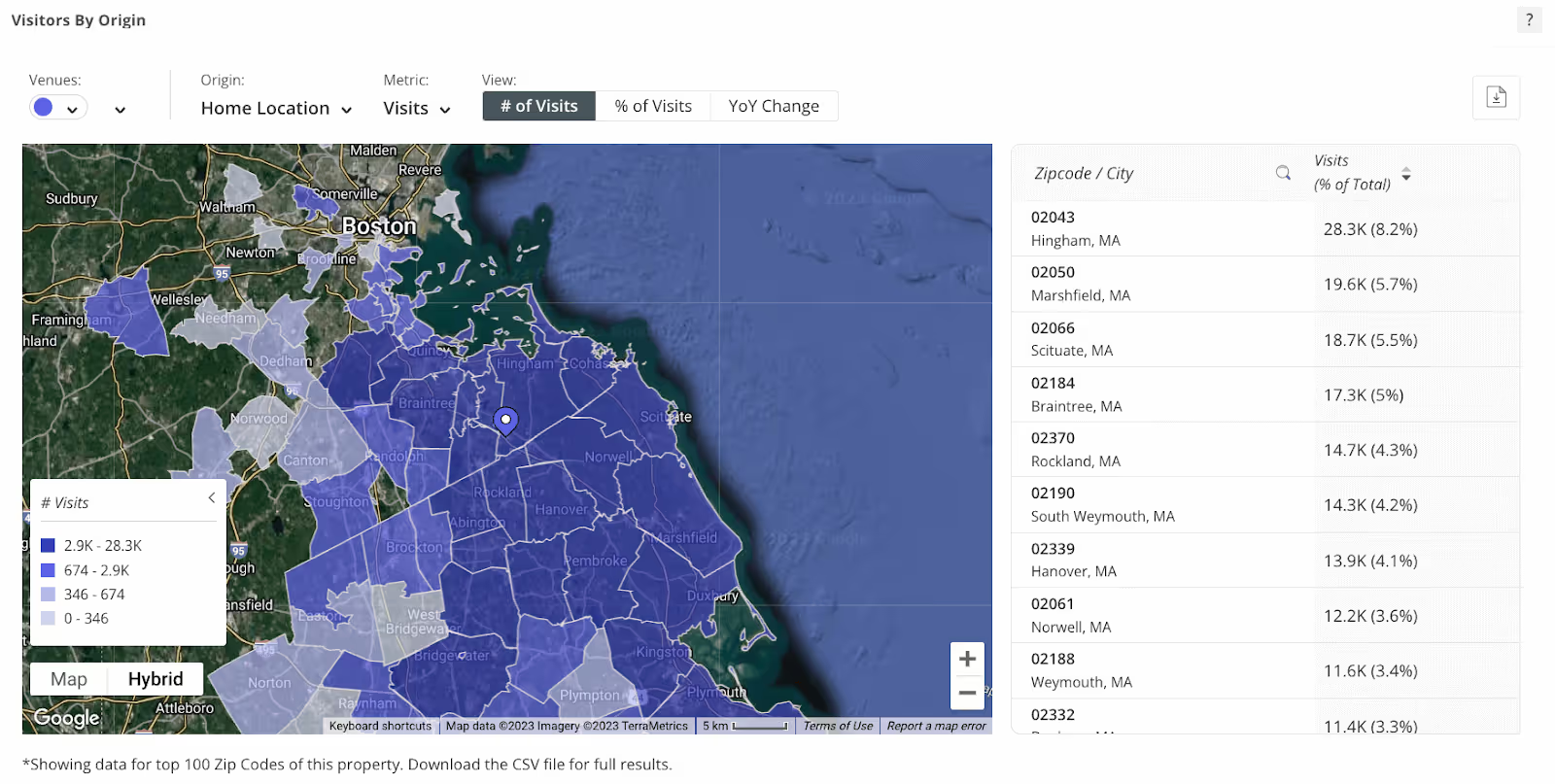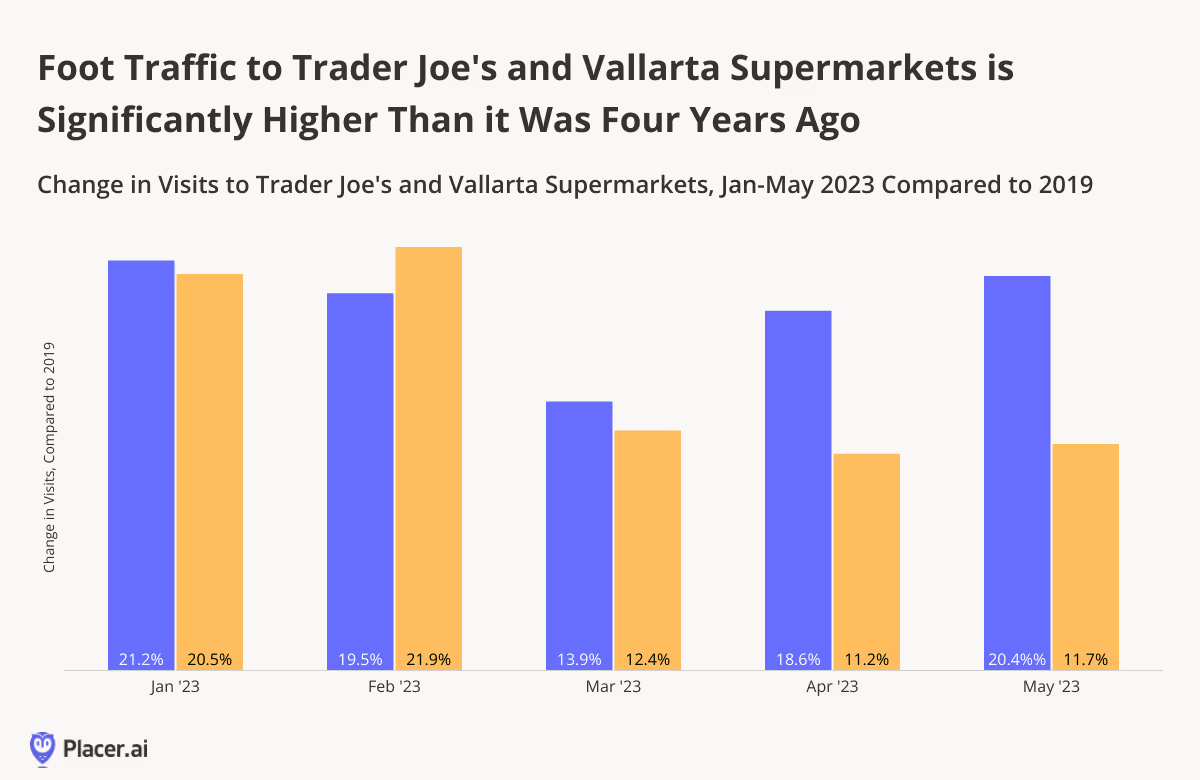What is Foot Traffic?
Foot traffic refers to the movement of pedestrians from place to place. In business, foot traffic (sometimes called “footfall”) is a metric used to measure the number of people who visit a particular venue or location during a specified period of time. Foot traffic data also provides visibility into the behavior and characteristics of visitors to various locations.
Professionals across industries analyze foot traffic patterns to understand human behavior and movement in the physical world:
- Retailers use foot traffic to assess the performance of stores and chains, to conduct trade area analysis and site selection, and to manage day-to-day operations.
- Commercial real estate (CRE) professionals analyze foot traffic to find ideal tenants for commercial properties, make investment decisions, and evaluate deals.
- Municipalities and BIDs (Business Improvement Districts) study foot traffic patterns to identify gaps in local services, promote economic development, and guide policy making.
- Advertisers use foot traffic data to create highly targeted promotions and to assess campaign performance.
- CPG (consumer packaged goods) companies utilize foot traffic analyses to optimize product placement and trade fund spend, and refine marketing efforts.
How to Measure Foot Traffic
In the past, practitioners had to rely on outdated methods like manual counting, motion sensors, focus groups, and customer interviews to understand foot traffic patterns and the habits and preferences of visitors to different places. But today, developments in AI and machine learning make it possible for businesses and other stakeholders to easily and efficiently glean actionable insights from foot traffic. With the help of aggregated, statistical data from mobile devices, location intelligence platforms provide highly accurate and customizable foot traffic analytics. These analytics reveal not just how many people visit a specific place, but also where they come from and where else they go – without compromising individual privacy.
Mobile-powered foot traffic analytics are also incredibly versatile. Practitioners can define for themselves the geographical scopes of the locations to be analyzed, as well as the relevant time periods. They can then analyze their customized audiences with other geospatial datasets, to determine the habits, characteristics, profiles, and preferences of people that visit particular places at particular times. The possibilities are virtually endless:
Zooming in and out: Foot traffic can be tracked and analyzed on almost any geographical level – whether nationwide, statewide, city-wide, or for specific locations. Geographic locations – including cities, retail corridors, business districts, and even specific buildings – can be defined as points of interest (POIs) where visitation patterns can be observed. Data can be aggregated, to allow for chain-level, market-level or other macro analyses, or broken down into hyper-local, bite-size pieces.
Competitive Benchmarking: Location analytics offer practitioners visibility into what’s happening not only in their own venues, but also at those of the competition. By analyzing foot traffic to other chains, locations, shopping centers, and geographical areas, professionals can conduct both broad and highly specific comparative benchmarking.
Analyzing changes over time: Changes and trends in foot traffic patterns can be analyzed on daily, hourly, monthly, or yearly bases, allowing professionals to measure the actual impacts of different strategies and determine performance over time.
Understanding visitor profiles: By combining foot traffic data with demographic, psychographic, and other datasets – and really, the sky’s the limit – analysts can conduct deep analyses of the defined audiences.
Foot Traffic in Action: Three Examples
The importance of foot traffic for business and civic stakeholders, and the specific kinds of insights that can be derived from its analysis, can be explained with a few concrete examples:
Managing a Retail Chain
Imagine you run a small chain of local grocery stores. By tracking foot traffic to each of your locations, you can:
- Identify top and under-performers: Which stores are emerging as hot destinations, and which are lagging behind?
- Inform store operations: When are your stores busiest, and when are they quiet? By determining your venues’ peak visitation times, you can ensure adequate staffing when the stores are busiest and reduce costs when they’re not.
- Assess conversion rates: Foot traffic data allows you to more deeply explore the relationship between sales and visitation rates. Which products sell consistently – even during low-traffic periods – and which move only when the stores are packed?
- Optimize inventory and product assortment: Foot traffic data, overlaid with demographic and psychographic datasets, also lets you understand the habits and characteristics of your chain’s customer base and optimize your merchandising strategy accordingly. You can analyze foot traffic to find out – Which of your venues attract more visitors from areas with lots of families with children, and when are such visitors most likely to visit? How likely are your visitors to be Gen Zers? What are the income profiles of the census block groups (CBGs) feeding visitors to your stores?
- Manage fleet configuration: The decision to open a new store or to close an existing one can have dramatic implications for your business – and it’s important to get it right. Foot traffic data can optimize every stage of the expansion or rightsizing process, from deciding whether it’s indeed the right time to move forward to choosing an ideal location for your new venue. Visitation patterns can also inform decisions to reduce a chain’s physical footprint by detecting cannibalization and underperforming venues.
- Stay on top of the competition: How do your visitation rates stack up to those of your main competitors? How do their audiences compare to yours in terms of shopping behavior and preferences?
- Improve promotional efforts: Where should you invest your advertising dollars? Analyzing foot traffic lets you create targeted marketing campaigns focused on those groups most likely to become customers.

Boosting Tourism to a City
Now imagine you’re a local government employee working with a Destination Marketing Organization (DMO) to make your city a more attractive tourist destination. Analyzing foot traffic patterns allows you to:
- Understand who’s visiting your city – and who’s not. By leveraging foot traffic data, you can identify the origins, habits, and demographic profiles of the tourists already most likely to visit your city and of groups that may represent untapped potential. What are the age and income distributions of the CBGs feeding visitors to local attractions? Which groups or areas could best be targeted for future tourism promotion?
- Optimize local infrastructure and amenities: Foot traffic data can serve to optimize infrastructure and amenities in high-traffic areas. For example, are there attractions that are popular among parents with young children but that lack kid-friendly restrooms and water fountains? By addressing any gaps in available facilities, you can enhance the overall tourist experience and attract more visitors.
- Attract the right retailers: Having the right mix of retailers can also be key to attracting tourists. Use foot traffic data to find out – Which brands does your tourist base visit frequently? Are there dining concepts that are particularly popular with your tourist base that are missing in your area? With foot traffic analytics you can identify the kinds of businesses most likely to appeal to your visitor base and make a strong case to bring them on board.
- Plan and assess the impact of tourism initiatives: Festivals, annual events, and other special initiatives can bring tourists flocking to your town. Which types of events bring overnight guests to your area, and which happenings attract visitors making a day trip? What limited-time attractions draw people from further away, and what events appeal more to locals? By analyzing changes in foot traffic patterns, you can measure the success of marketing campaigns, events, or infrastructure improvements. This evaluation allows you to make data-driven decisions for future tourism planning and investment.
Optimizing A CPG Product Launch
Suppose you represent a CPG company that is launching a new high-protein, vegan yogurt and wants to ensure that the product is placed with the right retailers. By leveraging foot traffic data you can:
- Assess retailers’ varying reach: Analyzing visitation patterns to grocery and specialty food chains can help you identify retailers with large – and growing – customer bases, where your product is likely to move. Sufficient customer reach is crucial for any launch – especially when it comes to perishable goods that will go bad if left to languish on the shelves.
- Find your target audience: Foot traffic data also allows you to segment the audiences of various retailers to find partners that attract your target customers: in this case, affluent, health-conscious vegans. If research indicates that your yogurt is most likely to resonate, say, with Gen Zers, you can also use foot traffic to analyze the generational breakdown of different retailers’ captured markets.
- Allocate trade and marketing budgets: Understanding the customer profiles of your partner retailers lets you create highly targeted advertising campaigns and decide how and where to invest your trade funds.

These are just a few of the ways that foot traffic patterns can be harnessed to generate business intelligence that drives informed decision-making. For additional examples and use cases across industries, check out more of our Guides here.
Placer.ai: Foot Traffic at Your Fingertips
Given the high stakes of decisions based on foot traffic data, it is critical to choose a location intelligence platform that is accurate, precise, comprehensive, and user-friendly – and that is constructed with a privacy-by-design approach.
Placer.ai’s location intelligence solution checks all these crucial boxes – providing professionals across industries with the tools they need to instantly analyze foot traffic for any specific commercial location or broader geographical area. Placer harnesses advanced data science and machine learning techniques to extrapolate foot traffic analytics from representative panels of location data. And with Placer’s user-friendly platform, anyone can quickly and efficiently analyze visitation to chains, stores, and other points of interest (POIs) nationwide.
Placer also features a broad range of psychographic and demographic datasets that customers can easily integrate into their analyses – as well as tools that can instantly process all the relevant information to find ideal locations for retailers and perfect tenants for shopping centers. To ensure privacy, all of Placer’s data is stripped of identifiers like names and MAIDs before it reaches the company – and provided to customers only in the form of aggregated, statistical information about physical locations.
Foot Traffic: Looking Ahead
Foot traffic – the foundation of any good location analytics platform – is a critical metric for understanding how people behave and where they go in the real world. By analyzing foot traffic, retailers, urban planners, CRE brokers, and others can gain valuable insights into consumer behavior, make informed decisions, and improve outcomes. As location intelligence capabilities continue to develop and become ever more sophisticated, access to accurate and up-to-date foot traffic data will become a must-have for businesses across industries.



